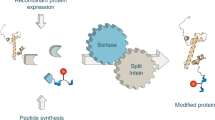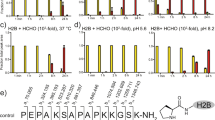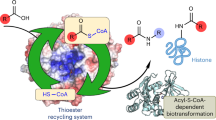Abstract
Chemical synthesis of histones allows precise control of the installation of post-translational modifications via the coupling of derivatized amino acids. Shortcomings of other approaches for obtaining modified histones for epigenetic studies include heterogeneity of the obtained product and difficulties in incorporating multiple modifications on the same histone. In this protocol, unprotected peptide fragments are prepared by Fmoc solid-phase synthesis and coupled in aqueous buffers via native chemical ligation (NCL; in NCL, a peptide bond is formed between a peptide with an N-terminal Cys and another peptide having a C-terminal thioester). This task is challenging, with obstacles relating to the preparation and ligation of hydrophobic peptides, as well as the requirement for multiple purification steps due to protecting-group manipulations during the polypeptide assembly process. To address this, our approach uses an easily removable solubilizing tag for the synthesis and ligation of hydrophobic peptides, as well as a more efficient and better-yielding method to remove Cys-protecting groups that uses palladium chemistry (specifically [Pd(allyl)Cl]2 and PdCl2 complexes). The utility of this approach is demonstrated in the syntheses of ubiquitinated H2B at Lys34, phosphorylated H2A at Tyr57 and unmodified H4. Each of these analogs can be prepared in milligram quantities within ∼20–30 d.
This is a preview of subscription content, access via your institution
Access options
Access Nature and 54 other Nature Portfolio journals
Get Nature+, our best-value online-access subscription
$29.99 / 30 days
cancel any time
Subscribe to this journal
Receive 12 print issues and online access
$259.00 per year
only $21.58 per issue
Buy this article
- Purchase on Springer Link
- Instant access to full article PDF
Prices may be subject to local taxes which are calculated during checkout







Similar content being viewed by others
References
Harmand, T.J., Murar, C.E. & Bode, J.W. Protein chemical synthesis by α-ketoacid–hydroxylamine ligation. Nat. Protoc. 11, 1130–1147 (2016).
Dawson, P.E., Muir, T.W., Clark-Lewis, I. & Kent, S.B. Synthesis of proteins by native chemical ligation. Science 266, 776–779 (1994).
Bondalapati, S., Jbara, M. & Brik, A. Expanding the chemical toolbox for the synthesis of large and uniquely modified proteins. Nat. Chem. 8, 407–418 (2016).
Kornberg, R.D. Structure of chromatin. Annu. Rev. Biochem. 46, 931–954 (1977).
Bannister, A.J. & Kouzarides, T. Regulation of chromatin by histone modifications. Cell Res. 21, 381–395 (2011).
Jenuwein, T. & Allis, C.D. Translating the histone code. Science 293, 1074–1080 (2001).
Strahl, B.D. & Allis, C.D. The language of covalent histone modifications. Nature 403, 41–45 (2000).
Maze, I., Noh, K.M., Soshnev, A.A. & Allis, C.D. Every amino acid matters: essential contributions of histone variants to mammalian development and disease. Nat. Rev. Genet. 15, 259–271 (2014).
Holt, M. & Muir, T. Application of the protein semisynthesis strategy to the generation of modified chromatin. Annu. Rev. Biochem. 84, 265–290 (2015).
Davis, L. & Chin, J.W. Designer proteins: applications of genetic code expansion in cell biology. Nat. Rev. Mol. Cell. Biol. 13, 168–182 (2012).
Spicer, C.D. & Davis, B.G. Selective chemical protein modification. Nat. Commun. 5, 4740 (2014).
Muller, M.M. & Muir, T.W. Histones: at the crossroads of peptide and protein chemistry. Chem. Rev. 115, 2296–2349 (2015).
Maity, S.K., Jbara, M. & Brik, A. Chemical and semisynthesis of modified histones. J. Pept. Sci. 22, 252–259 (2016).
Zheng, J.-S., Tang, S., Qi, Y.-K., Wang, Z.-P. & Liu, L. Chemical synthesis of proteins using peptide hydrazides as thioester surrogates. Nat. Protoc. 8, 2483–2495 (2013).
Siman, P., Karthikeyan, S.V., Nikolov, M., Fischle, W. & Brik, A. Convergent chemical synthesis of histone H2B protein for the site-specific ubiquitination at Lys34. Angew. Chem. Int. Ed. Engl. 52, 8059–8063 (2013).
Seenaiah, M., Jbara, M., Mali, S.M. & Brik, A. Convergent versus sequential protein synthesis: the case of ubiquitinated and glycosylated H2B. Angew. Chem. Int. Ed. Engl. 54, 12374–12378 (2015).
Pentelute, B.L. & Kent, S.B. Selective desulfurization of cysteine in the presence of Cys(Acm) in polypeptides obtained by native chemical ligation. Org. Lett. 9, 687–690 (2007).
David, Y., Vila-Perello, M., Verma, S. & Muir, T.W. Chemical tagging and customizing of cellular chromatin states using ultrafast trans-splicing inteins. Nat. Chem. 7, 394–402 (2015).
Johnson, E.C. et al. Modular total chemical synthesis of a human immunodeficiency virus type 1 protease. J. Am. Chem. Soc. 129, 11480–11490 (2007).
Fang, G.M., Wang, J.X. & Liu, L. Convergent chemical synthesis of proteins by ligation of peptide hydrazides. Angew. Chem. Int. Ed. Engl. 51, 10347–10350 (2012).
Li, J., Li, Y., He, Q., Li, H. & Liu, L. One-pot native chemical ligation of peptide hydrazides enables total synthesis of modified histones. Org. Biomol. Chem. 12, 5435–5441 (2014).
Jbara, M., Maity, S.K., Seenaiah, M. & Brik, A. Palladium mediated rapid deprotection of N-terminal cysteine under native chemical ligation conditions for the efficient preparation of synthetically challenging proteins. J. Am. Chem. Soc. 138, 5069–5075 (2016).
Jbara, M., Laps, S., Maity, S.K. & Brik, A. Palladium-assisted cleavage of peptides and proteins containing a backbone with thiazolidine linkage. Chem. Eur. J. 22, 14851–14855 (2016).
Maity, S.K., Jbara, M., Laps, S. & Brik, A. Efficient palladium-assisted one-pot deprotection of (acetamidomethyl)cysteine following native chemical ligation and/or desulfurization to expedite chemical protein synthesis. Angew. Chem. Int. Ed. Engl. 55, 8108–8112 (2016).
Lechner, C.C., Agashe, N.D. & Fierz, B. Traceless synthesis of asymmetrically modified bivalent nucleosomes. Angew. Chem. Int. Ed. Engl. 55, 2903–2906 (2016).
Yang, Y.Y., Ficht, S., Brik, A. & Wong, C.H. Sugar-assisted ligation in glycoprotein synthesis. J. Am. Chem. Soc. 129, 7690–7701 (2007).
Maity, S.K. et al. Palladium-assisted removal of a solubilizing tag from a Cys side chain to facilitate peptide and protein synthesis. Org. Lett. 18, 3026–3029 (2016).
Jbara, M., Maity, S.K., Morgan, M., Wolberger, C. & Brik, A. Chemical synthesis of phosphorylated histone H2A at Tyr57 reveals insight into the inhibition mode of the SAGA deubiquitinating module. Angew. Chem. Int. Ed. 55, 4972–4976 (2016).
Wu, L., Zee, B.M., Wang, Y., Garcia, B.A. & Dou, Y. The RING finger protein MSL2 in the MOF complex is an E3 ubiquitin ligase for H2B K34 and is involved in crosstalk with H3 K4 and K79 methylation. Mol. Cell. 43, 132–144 (2011).
Blanco-Canosa, J.B. & Dawson, P.E. An efficient Fmoc-SPPS approach for the generation of thioester peptide precursors for use in native chemical ligation. Angew. Chem. Int. Ed. Engl. 47, 6851–6855 (2008).
Erlich, L.A., Kumar, K.S., Haj-Yahya, M., Dawson, P.E. & Brik, A. N-methylcysteine-mediated total chemical synthesis of ubiquitin thioester. Org. Biomol. Chem. 8, 2392–2396 (2010).
Kumar, K.S.A., Haj-Yahya, M., Olschewski, D., Lashuel, H.A. & Brik, A. Highly efficient and chemoselective peptide ubiquitylation. Angew. Chem. Int. Ed. Engl. 48, 8090–8094 (2009).
Moyal, T., Hemantha, H.P., Siman, P., Refua, M. & Brik, A. Highly efficient one-pot ligation and desulfurization. Chem. Sci. 4, 2496–2501 (2013).
Basnet, H. et al. Tyrosine phosphorylation of histone H2A by CK2 regulates transcriptional elongation. Nature 516, 267–271 (2014).
Morgan, M.T. et al. Structural basis for histone H2B deubiquitination by the SAGA DUB module. Science 351, 725–728 (2016).
Zuo, C., Tang, S. & Zheng, J.S. Chemical synthesis and biophysical applications of membrane proteins. J. Pept. Sci. 21, 540–549 (2015).
Rusiecki, V.K. & Warne, S.A. Synthesis of N-alpha-Fmoc-N-epsilon-Nvoc-lysine and use in the preparation of selectively functionalized peptides. Bioorg. Med. Chem. Lett. 3, 707–710 (1993).
Haj-Yahya, M., Kumar, K.S.A., Erlich, L.A. & Brik, A. Protecting group variations of delta-mercaptolysine useful in chemical ubiquitylation. Biopolymers 94, 504–510 (2010).
Carpino, L.A. et al. The uronium/guanidinium peptide coupling reagents: finally the true uronium salts. Angew. Chem. Int. Ed. Engl. 41, 442–445 (2002).
Siman, P. et al. Chemical synthesis and expression of the HIV-1 rev protein. Chembiochem 12, 1097–1104 (2011).
Smith, A.B., Savinov, S.N., Manjappara, U.V. & Chaiken, I.M. Peptide-small molecule hybrids via orthogonal deprotection-chemoselective conjugation to cysteine-anchored scaffolds. A model study. Org. Lett. 4, 4041–4044 (2002).
Freidinger, R.M., Hinkle, J.S., Perlow, D.S. & Arison, B.H. Synthesis of 9-fluorenylmethyloxycarbonyl-protected N-alkyl amino-acids by reduction of oxazolidinones. J. Org. Chem. 48, 77–81 (1983).
Royo, M., Alsina, J., Giralt, E., Slomcyznska, U. & Albericio, F. S-phenylacetamidomethyl (Phacm) - an orthogonal cysteine protecting group for Boc and Fmoc solid-phase peptide-synthesis strategies. J. Chem. Soc. 1, 1095–1102 (1995).
Acknowledgements
A.B. is a Neubauer Professor and a Taub Fellow supported by the Taub Foundation. S.K.M. thanks Israel's Council of Higher Education for a fellowship under the PBC program. M.J. thanks the Israel Council of Higher Education for a fellowship under his PhD program.
Author information
Authors and Affiliations
Contributions
S.K.M., M.J., G.M. and G.K. performed the experiments, compound characterization and data analysis. All the authors discussed the experimental design and contributed to writing the manuscript.
Corresponding author
Ethics declarations
Competing interests
The authors declare no competing financial interests.
Supplementary information
Supplementary Text and Figures
Supplementary Figures 1–30. (PDF 3038 kb)
Rights and permissions
About this article
Cite this article
Maity, S., Jbara, M., Mann, G. et al. Total chemical synthesis of histones and their analogs, assisted by native chemical ligation and palladium complexes. Nat Protoc 12, 2293–2322 (2017). https://doi.org/10.1038/nprot.2017.049
Published:
Issue Date:
DOI: https://doi.org/10.1038/nprot.2017.049
This article is cited by
-
Interrogating epigenetic mechanisms with chemically customized chromatin
Nature Reviews Genetics (2024)
-
Diselenide–selenoester ligation for chemical protein synthesis
Nature Protocols (2019)
-
Recent advances in the chemical synthesis and semi-synthesis of poly-ubiquitin-based proteins and probes
Science China Chemistry (2019)
-
Palladium prompted on-demand cysteine chemistry for the synthesis of challenging and uniquely modified proteins
Nature Communications (2018)
Comments
By submitting a comment you agree to abide by our Terms and Community Guidelines. If you find something abusive or that does not comply with our terms or guidelines please flag it as inappropriate.



